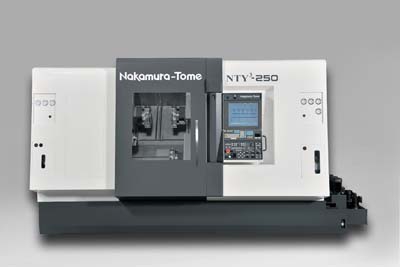
Methods Machine Tools Inc. has introduced the Nakamura-Tome NTY3-250 Multitasking Turning Center. The new NTY3-250 has three high rigidity turrets, each with a Y-axis of 4.4 inches (112mm). The NTY3-250 dramatically outperforms two-turret multitasking machines and can eliminate downtime due to tool changeovers with its 72-tool capacity. This allows for short cycles times and complete turning/machining/finishing capabilities.
The new NTY3-250 provides X-axis and Z-axis speeds of 1,181 lpm and 1,574 lpm respectively. To accommodate these high speeds, the machine significantly outweighs its competition at 31,807 lbs. (14,425 Kg) to ensure rugged, stable performance. Designed with a long 47.24" (1,200mm) distance between spindles to eliminate any interference of tooling during multitasking, the NTY3-250 allows for multiple tools in the cut simultaneously. The NTY3-250 also features a 60 degree slant bed for easy access to the work and tooling, in addition to better chip flow.
Each of the three turrets holds 12 driven or 24 stationary tools, for a maximum of 72 tool stations. Up to 35/30 HP is available for shaft/work turning with synchronized spindles. The NTY3-250 has a maximum turning diameter of 8.86" (225mm), a maximum turning length of 35.65" (905.5mm) and a 2.5" (65mm) bar capacity.
"With the introduction of the Super NTY3-250 we are able to offer a multitasking turning center with three turrets having identical performance and capabilities," said Richard Parenteau, Director of Application Development at Methods Machine Tools.
For ease-of-operation, the NTY3-250 features a large 19" high-resolution, touch screen LCD panel. The Nakamura-Tome Intelligent Programming System (NT-IPS) is a PC-based control that is built into the machine. It works in conjunction with the latest Fanuc 31i-B controller to give a high degree of functionality, coupled with fast processing speeds. New standard functions include a spindle speed override switch, a program number search, C-axis synchronization and helical interpolation.
Unlike conventional CNC interfaces, which involve extensive menu selections and navigation through numerous screens, the NT-IPS is able to present a large amount of information in a clear format and allow simple one-touch access to all setting functions for faster set up and programming. The trouble guidance feature helps users quickly identify and respond to machine error signals by delivering a description of the error and possible causes, along with a series of pictures that show the location of the problem.
CAMplete TruePath Turn/Mill software is standard on Nakamura-Tome Multitasking Turning Centers. CAMplete Turn/Mill software is an integrated suite of G-Code editing, optimization, analysis and verification tools, enabling a full range of turn/ mill functions.
Contact Details
Related Glossary Terms
- centers
centers
Cone-shaped pins that support a workpiece by one or two ends during machining. The centers fit into holes drilled in the workpiece ends. Centers that turn with the workpiece are called “live” centers; those that do not are called “dead” centers.
- computer numerical control ( CNC)
computer numerical control ( CNC)
Microprocessor-based controller dedicated to a machine tool that permits the creation or modification of parts. Programmed numerical control activates the machine’s servos and spindle drives and controls the various machining operations. See DNC, direct numerical control; NC, numerical control.
- interpolation
interpolation
Process of generating a sufficient number of positioning commands for the servomotors driving the machine tool so the path of the tool closely approximates the ideal path. See CNC, computer numerical control; NC, numerical control.
- milling machine ( mill)
milling machine ( mill)
Runs endmills and arbor-mounted milling cutters. Features include a head with a spindle that drives the cutters; a column, knee and table that provide motion in the three Cartesian axes; and a base that supports the components and houses the cutting-fluid pump and reservoir. The work is mounted on the table and fed into the rotating cutter or endmill to accomplish the milling steps; vertical milling machines also feed endmills into the work by means of a spindle-mounted quill. Models range from small manual machines to big bed-type and duplex mills. All take one of three basic forms: vertical, horizontal or convertible horizontal/vertical. Vertical machines may be knee-type (the table is mounted on a knee that can be elevated) or bed-type (the table is securely supported and only moves horizontally). In general, horizontal machines are bigger and more powerful, while vertical machines are lighter but more versatile and easier to set up and operate.
- multifunction machines ( multitasking machines)
multifunction machines ( multitasking machines)
Machines and machining/turning centers capable of performing a variety of tasks, including milling, drilling, grinding boring, turning and cutoff, usually in just one setup.
- turning
turning
Workpiece is held in a chuck, mounted on a face plate or secured between centers and rotated while a cutting tool, normally a single-point tool, is fed into it along its periphery or across its end or face. Takes the form of straight turning (cutting along the periphery of the workpiece); taper turning (creating a taper); step turning (turning different-size diameters on the same work); chamfering (beveling an edge or shoulder); facing (cutting on an end); turning threads (usually external but can be internal); roughing (high-volume metal removal); and finishing (final light cuts). Performed on lathes, turning centers, chucking machines, automatic screw machines and similar machines.







